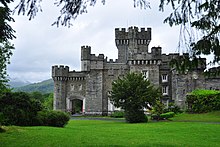
Helen Beatrix Potter was an English writer, illustrator, natural scientist, and conservationist. She is best known for her children's books featuring animals, such as The Tale of Peter Rabbit, which was her first commercially published work in 1902. Her books, including 23 Tales, have sold more than 250 million copies. An entrepreneur, Potter was a pioneer of character merchandising. In 1903, Peter Rabbit was the first fictional character to be made into a patented stuffed toy, making him the oldest licensed character.
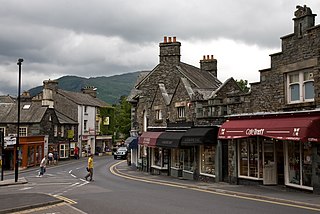
Ambleside is a town and former civil parish in the Westmorland and Furness district of Cumbria, England. Within the boundaries of the historic county of Westmorland and located in the Lake District National Park, the town sits at the head of Windermere, England's largest natural lake. In 2020 it had an estimated population of 2596.

Windermere is a ribbon lake in Cumbria, England, and part of the Lake District. It is the largest lake in England by length, area, and volume, but considerably smaller than the largest Scottish lochs and Northern Irish loughs.

Windermere is a town in the civil parish of Windermere and Bowness, in the Westmorland and Furness district in the ceremonial county of Cumbria, England; it is within the Lake District National Park. The town lies about half a mile (1 km) east of the lake, Windermere, from which it takes its name. In 2021 it had a population of 4826.

Grasmere is a village and former civil parish, now in the parish of Lakes, in the Westmorland and Furness district of Cumbria, England, and situated in the centre of the Lake District and named after its adjacent lake. Grasmere lies within the historic county of Westmorland. The Ambleside and Grasmere ward had an estimated population of 4,592 in 2019. William and Dorothy Wordsworth, the 'Lake Poets', lived in Grasmere for 14 years and called it "the loveliest spot that man hath ever found."

Hill Top is a 17th-century house in Near Sawrey near Hawkshead, in the English county of Cumbria. It is an example of Lakeland vernacular architecture with random stone walls and slate roof. The house was once the home of children's author and illustrator Beatrix Potter who left it to the National Trust. It is a Grade II* listed building. It is open to the public as a writer's house museum, shown as Beatrix Potter herself would have known it.

Hardwicke Drummond Rawnsley was an Anglican priest, poet, local politician and conservationist. He became nationally and internationally known as one of the three founders of the National Trust for Places of Historic Interest or Natural Beauty in the 1890s.

Bowness-on-Windermere is a town and former civil parish, now in the parish of Windermere and Bowness, in the Westmorland and Furness district, in the ceremonial county of Cumbria, England. It lies next to Windermere lake and the town of Windermere to the north east and within the Lake District National Park. The town was historically part of the county of Westmorland and is also forms an urban area with Windermere. The town had a population of 3,814 in the 2011 Census.
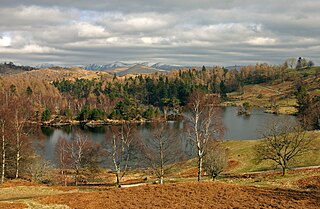
Tarn Hows is an area of the Lake District National Park in North West England, It contains a picturesque tarn, approximately 2 miles (3.2 km) northeast of Coniston and about 1.5 miles (2.4 km) northwest of Hawkshead. It is one of the most popular tourist destinations in the area with over half a million visitors per year in the 1970s and is managed by the National Trust.
Windermere and Troutbeck (including Bridge House) is a National Trust property consisting of land around Windermere, a lake in Cumbria, England.
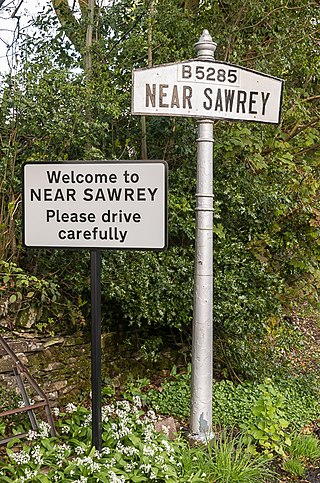
Near Sawrey and Far Sawrey are two neighbouring villages in the Furness area of Cumbria, England. Within the boundaries of the historic county of Lancashire, both are located in the Lake District between the village of Hawkshead and the lake of Windermere. The two lie on the B5285, which runs from Hawkshead to the west bank of the Windermere Ferry, a car ferry across Windermere 1 mile to the east of the villages.

Black Fell is a fell in the English Lake District. It rises to the north of Tarn Hows, between Coniston and Hawkshead.

The Armitt Museum, also known as the Armitt Museum and Library, is an independent museum and library, founded in Ambleside in Cumbria by Mary Louisa Armitt in 1909. It is a registered charity under English law.

Rydal is a village in Cumbria, England. It is a small cluster of houses, a hotel, and St Mary's Church, on the A591 road midway between Ambleside and Grasmere.

The Windermere Way is a 45-mile circuit of Windermere, a lake in the English Lake District. The route is wholly within the Lake District National Park and takes in the summits of Wansfell, Loughrigg Fell and Gummer's How as well as passing through the towns of Ambleside and Windermere.

Claife is a civil parish in the South Lakeland district of Cumbria, England. It is situated west of Windermere, and east of Esthwaite Water and the village of Hawkshead. In the 2001 census the parish had a population of 392, reducing to 298 at the 2011 census. Settlements in the parish include two villages, Near and Far Sawrey in the south; and the hamlets of High Wray, Low Wray, Colthouse and Loanthwaite in the north.

Moss Eccles Tarn is a tarn on Claife Heights, near Near Sawrey in the Lake District, Cumbria. It is currently owned by the National Trust and known as an attractive tarn for fishing and walking. It is known for its association with Beatrix Potter – she owned the tarn and donated it to the National Trust after her death, and it served as inspiration for some of her stories.
Claife is a civil parish in the South Lakeland District of Cumbria, England. It contains 45 listed buildings that are recorded in the National Heritage List for England. Of these, four are listed at Grade II*, the middle of the three grades, and the others are at Grade II, the lowest grade. The parish is in the Lake District National Park to the west of Windermere. It contains the villages and settlements of Far Sawrey, Near Sawrey, Colthouse, Loanthwaite, High Wray and Low Wray, and the surrounding countryside. Most of the listed buildings are farmhouses, farm buildings, and houses with associated structures. The other listed buildings include churches, a public house, and a bridge.
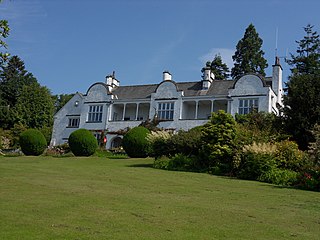
The Brockhole Lake District Visitor Centre, also known as the Brockhole National Park Visitor Centre, is a visitor centre and tourist attraction managed by the Lake District National Park Authority. It is situated on the shore of Lake Windermere, roughly equidistant between the towns of Bowness-on-Windermere and Ambleside. It includes the Brockhole house and 30 acres (12 ha) of grounds, including 10 acres (4.0 ha) of formal gardens and an adventure playground. The centre organises a number of activities, including orienteering, kayaking and open water swimming, as well as regular exhibitions.


